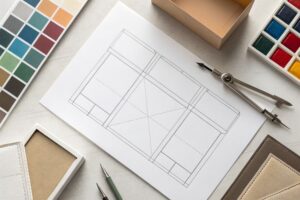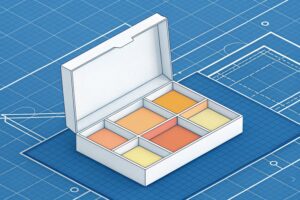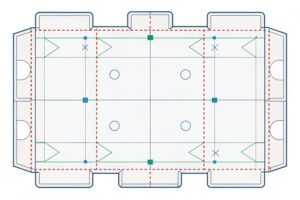设置商店显示时,它叫什么?

您希望顾客驻足。您的产品需要关注。我每周都会看到这种情况。清晰的条款和功能可以减少混淆,并加快结果。
设置店铺陈列被称为零售商品陈列或视觉商品陈列安装。许多团队称之为商品陈列重置、设置或规划图执行。目标是打造合规、可购买的商品展示,从而快速提升销量。

我会尽量保持语言简洁实用。我会用商店团队的语言来命名。我还会添加我们在北美、欧洲和快速发展的亚太地区纸板展示项目的实地笔记。
商店显示器叫什么?
团队使用许多名称。不同的买家喜欢不同的术语。我会为每个客户制定一个简短的清单。清晰的名称可以避免规格错误和后期变更。
商店展示架又称POP或POS展示架。常见的类型包括落地式展示架、台面式展示架、托盘式展示架、货架托盘、条形展示架、端盖式展示架和互动单元。纸板展示架速度快、灵活且经济实惠。
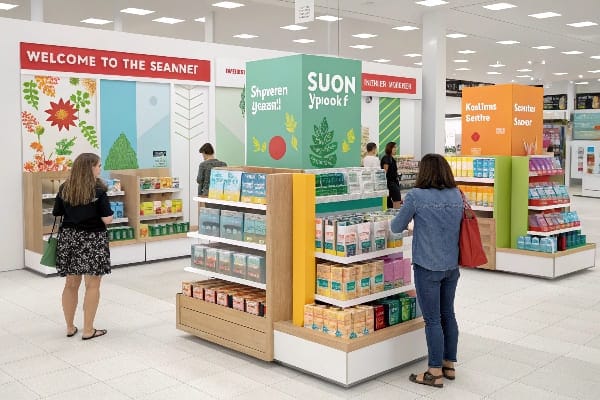
常见类型和最佳用途
我根据购物者接触展示品的地点和用途对展示品进行分组。纸板效果很好,因为它印刷速度快、运输平整、安装快捷。地板展示架1通常承载量最大,视觉冲击力最强。许多报告都指出,地板展示架占据了 POP 份额的 43.7% 左右,我在实际项目中也看到了这种情况。台面展示架在冲动购买方面胜出。托盘展示架在俱乐部渠道和大型仓储式商店中提升销量。货架托盘和夹条在拥挤的过道中创造小而可重复的效果。当故事需要动感或数据时,互动和数字化可以增加参与度。可持续性2现在影响着许多选择。买家要求再生纸板、水性油墨和更轻盈的设计。亚太地区在城市零售和电子商务提货方面发展迅速。欧洲推行生态规则和可回收涂料。北美保持稳定,需要速度。数字印刷有助于小批量生产、季节性测试和个性化。
| 类型 | 最好的用途 | 典型的寿命 | 笔记 |
|---|---|---|---|
| 地面 | 新品发布,主打SKU | 4–12周 | 影响巨大,足迹更大 |
| 台面 | 冲动,附加组件 | 2–8周 | 小型,靠近收银台 |
| 托盘 | 音量,俱乐部 | 4–12周 | 托盘运输和销售 |
| 货架托盘 | 线路阻塞 | 4–12周 | 适合现有货架 |
| 夹条 | 填补空白 | 2-6周 | 低成本、轻便的物品 |
谁设置了商店显示?
许多人都在操作同一个设备。混乱浪费了时间。我提前分配了所有负责人,并在一页纸上记录了所有职责。
陈列品由店内销售人员、第三方重置人员、品牌代表或店员设置。设计师和工厂提供配套零件和指南。安装人员遵循货架平面图、安全规则和照片验证步骤。
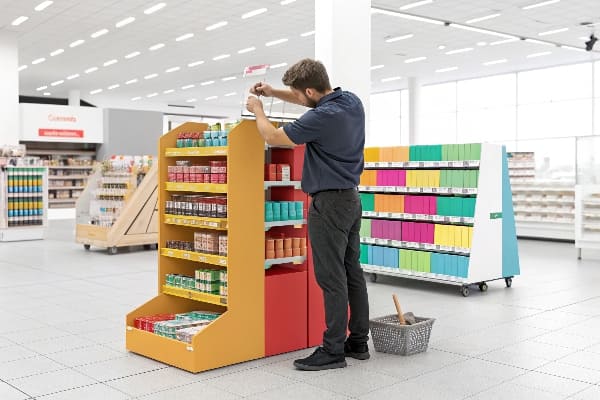
角色图,实现流畅设置
我从设计到车间都保持清晰的交接。品牌设定目标和时间安排。工厂生产测试样品,进行强度和运输测试,并包装一个带有标签零件的平板套件。3D 渲染图3和一页快速指南。零售商发布规划图和窗口时间。重置人员或商店团队执行设置。品牌代表检查合规性并拍照。这看起来很简单,但小差距会造成大麻烦。我在为一位日期严格的美国客户举办的狩猎装备发布会上学到这一点。我们通过提前两周锁定角色并对零件进行颜色编码来避免错失销售。我们还在指南上打印了二维码,以显示 30 秒的安装视频。这个简单的步骤缩短了安装时间。它还减少了损坏的退货。在紧张的窗口期内,我会使用预审核电话和最终的“Go/No-Go”清单。
| 角色 | 重点任务 | 什么时候 | 错过的风险 |
|---|---|---|---|
| 品牌 | 目标、预算、SKU | 第 -8 周至第 -4 周 | 范围蔓延 |
| 设计师 | 结构、艺术、模切线 | 第 -8 周至第 -3 周 | 拟合误差 |
| 工厂 | 样品、测试、配套 | 第 -6 周至第 -2 周 | 破损 |
| 零售商 | 平面图、窗口 | 第 -3 周至第 0 周 | 禁止访问 |
| 安装程序 | 建造,照片证明 | 第 0 天 | 不合规 |
| 代表/质检 | 审计、修复、报告 | 第 0 天至第 3 天 | 销售损失 |
什么是商品展示?
购物者做决定的速度很快。好的陈列能减缓视线,加快选择速度。我的设计就是为了满足这种需求。
商品陈列是一种在购买点推广产品的实体展示方式。它结合结构、图形和位置来引导注意力、解释价值,并将兴趣转化为销售。

解剖和性能指标
我把每个展示架都当成一个小商店。结构承重且不变形。图形传达品牌、效益和价格。布局引导到达和流动。纸板是我的默认材料,既快速又省钱。它打印干净,折叠平整,而且容易回收。数码印刷让我可以进行短期测试和季节性艺术创作,不会浪费。我跟踪简单的数字。我每周销售率4 环保涂层5或更坚固的瓦楞纸等级。当故事复杂时,互动单元可以添加传感器或小屏幕。在一些连锁店中,收银台附近的快速“PDQ”托盘显示出强大的推动力。我将所有选择与当地法规和可持续发展目标相结合。现在许多买家要求以再生材料和水性油墨为基准。
| 元素 | 目的 | 我如何验证 | 升级选项 |
|---|---|---|---|
| 结构 | 强度和稳定性 | 负载和跌落测试 | 更重的笛子,更智能的折叠 |
| 图形 | 信息和品牌 | 颜色绘制 | 局部上光、AR 马克笔 |
| 硬件 | 快速组装 | 试点安装 | 自动锁,零件更少 |
| 包装 | 安全运输 | ISTA 检查 | 更好的护垫,更合适的盖子 |
| 数据 | 销售量、照片 | 简单的仪表板 | QR 审核、物联网标签 |
商店布局叫什么?
布局决定了人流量和时间。巧妙的规划能让显示屏在更小的空间内发挥更大的作用。
商店布局也称为平面图或零售布局。常见的布局形式包括网格式、跑道式(环形)、自由流动式和精品式。布局引导人流、视线,以及端盖、货盘和消费点的展示区域。

布局模式和展示策略
我将显示类型与布局流程相匹配。在网格布局6,购物者在笔直的过道中移动,因此我专注于穿过视觉噪音的端盖和货架托盘。在赛道计划中,交通绕周边运行,因此我将托盘或地板单元放置在环路的慢速角落。在自由流动或精品店7,我使用小型地板和立管,在英雄产品附近讲述一个紧凑的故事。我还遵守安全和 ADA 规则并保持走道畅通。我使用规划图、热图和简单的 A/B 测试进行规划。我在收银台附近放置快速抓取的 PDQ 托盘。我在前面附近但远离瓶颈处搭建季节性塔。对于俱乐部商店,我设计托盘展示架,它们在一个单元中运输和销售。为了实现环保目标,我选择更轻的纸板等级和水性油墨。我的设计考虑到了快速拆卸和易于回收,因为团队在促销后行动迅速。
| 布局 | 交通流量 | 最好的 | 显示提示 |
|---|---|---|---|
| 网格 | 直通道 | 食品杂货、药品 | 击打端盖;使用托盘 |
| 赛马场 | 循环路径 | 大卖场、百货商场 | 将托盘放置在缓慢转弯处 |
| 自由流动 | 灵活的路径 | 专业 | 使用小型地板;故事优先 |
| 精品店 | 类似房间的区域 | 奢华,精心策划 | 重点场景;丰富的图形 |
结论
清晰的名称、明确的职责和简洁的方案,让陈列效果显著。我使用快速搭建的纸板、清晰的图形和巧妙的摆放方式,将货架空间转化为销量。

